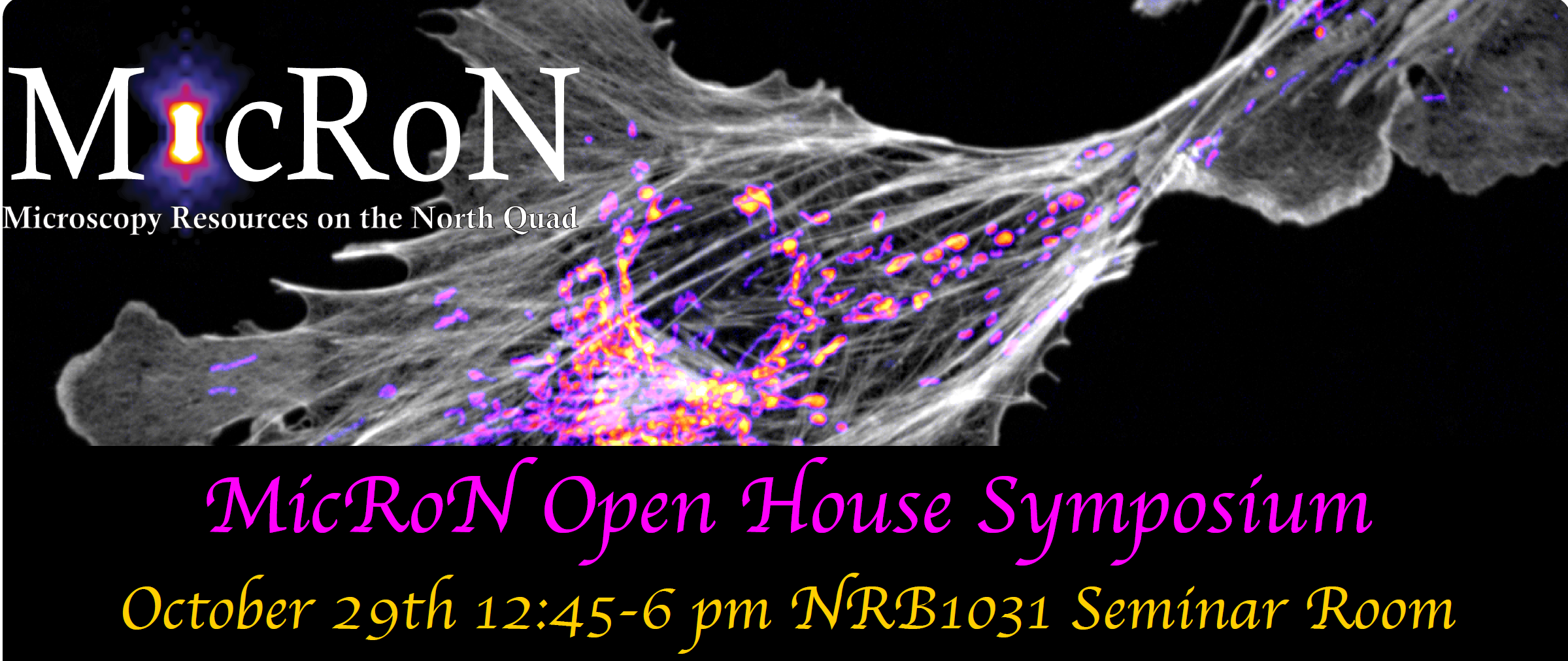Please join MicRoN at celebrating our trainees in Oct 29th 2025, 12:45-6:30 pm VSC1031 for our Open House Symposium. Discover how MicRoN can support your image-based research, meet our trainees and colleagues, interact with MicRoN staff and see our cutting-edge instruments in action. Everyone is welcome! Harvard and non-Harvard researchers, biotechs, and anyone interested in science and microscopy.
Please RSVP here: 2025 Open House Registration
2025 Open House Talks
Time | Speaker | Lab | Title |
|---|---|---|---|
| 1245-1250 | Paula Montero Llopis | MicRoN | Welcome to MicRoN Open House Symposium |
| 1250-0110 | Peter Back | Dvorin | Expansion microscopy and DNA-PAINT on the tiny malaria parasite |
| 0110-0130 | Ryan McMillan | Yin | Simple multiplexed immunofluorescence (Simpl-IF) coupled with STED microscopy enables exploration of cellular organisation at super-resolution |
| 0130-0150 | Jess Dixon | Goodrich | Pioneering in the Periphery: Exploring How Glial Precursors Pattern the Cochlea |
| 0150-0200 | Coffee Break | ||
| 0200-0220 | Muhammad Ahmad | Perrimon | Understanding how nutrients influence hormonal cell signalling & finding new targets to control fat storage |
| 0220-0240 | Chris Morrow | Maier | MoMA uncovers design principles of subcellular architecture |
| 0240-0300 | Dharmendra Puri | Engle | Role of microtubule dynamics in disorders of cranial motor axon development |
| 0300-0310 | Paula Montero Llopis | MicRoN | Announcement of M@gic Imaging Contest Winners |
| 0315-0530 | MicRoN site tours (register here) | ||
| 0530-0630 | |||
Speaker Details
Ryan McMillan / Yin Lab
Simple multiplexed immunofluorescence (Simpl-IF) coupled with STED microscopy enables exploration of cellular organisation at super-resolutionRyan McMillan is a fifth-year graduate student in biophysics, co-advised by Professors Wesley Wong and Peng Yin. He develops methods for multiplexed protein visualization with super-resolution imaging. He’s always excited about new applications of these methods, so please send him an email if you think your research could benefit from this technology!
Chris Morrow / Maier Lab
MoMA uncovers design principles of subcellular architectureChris Morrow is a postdoctoral researcher in Dr. William Mair's group at the Harvard School of Public Health where he uses fluorescence microscopy and C. elegans to study why animals age.
Muhammad Ahmad / Perrimon Lab
Understanding how nutrients influence hormonal cell signalling & finding new targets to control fat storageMuhammad Ahmad is a final year Ph.D. candidate in the Biological and Biomedical Sciences program, working in the Dr. Norbert Perrimon's Lab. His research focuses on how nutrients influence hormone signaling and lipid metabolism. He has developed functional assays for glucagon signaling and carried out genome-wide CRISPR-Cas9 screens and developed imaging based systems to uncover regulators of GPCR signaling and lipid droplet biology. These approaches reveal new mechanisms linking nutrient sensing to energy storage, with implications for metabolic disease
Peter Back / Dvorin Lab
Expansion microscopy and DNA-PAINT on the tiny malaria parasitePeter Back is a postdoctoral fellow in the Dvorin Lab at Boston Children’s Hospital. He is studying cell division of the malaria parasite, using genetic tools and super resolution microscopy to understand the molecular details. Peter obtained his PhD in Molecular Biology at UCLA, where he discovered novel compartments and functions for a specialized organelle in the related parasite Toxoplasma gondii. His overall research interests lie in the fundamental cell biology of understudied organisms, particularly those that cause human disease
Dharmendra Puri / Engle Lab
Role of microtubule dynamics in disorders of cranial motor axon developmentDharmendra conducted his PhD in Anindya Ghosh Roy`s lab at the National Brain Research Center in India, where he studied the regulation of microtubule cytoskeleton in C. elegans mechanosensory neurons. He joined the Engle lab at Boston Children’s Hospital/HMS in July 2022
Jess Dixon / Goodrich Lab
Pioneering in the Periphery: Exploring How Glial Precursors Pattern the CochleaJessica Dixon is a 4th year Neuroscience PhD candidate at Harvard Medical School, Howard Hughes Medical Institute (HHMI) Gilliam Fellow, and National Science Foundation Graduate Research Program (NSF-GRFP) Fellow. Her research in the Goodrich lab focuses on how glia and neurons work together to build the nervous system in the inner ear.
